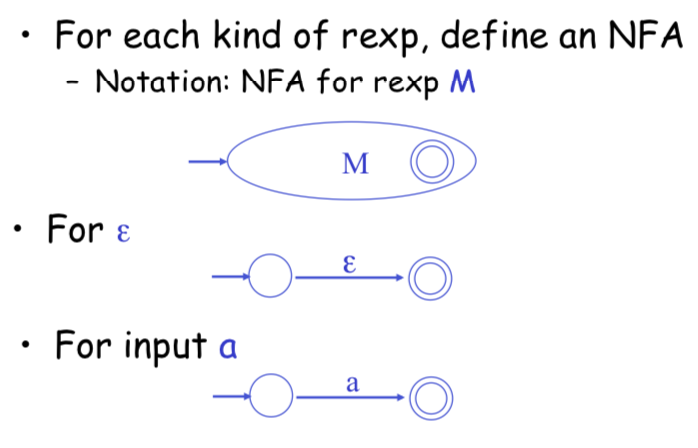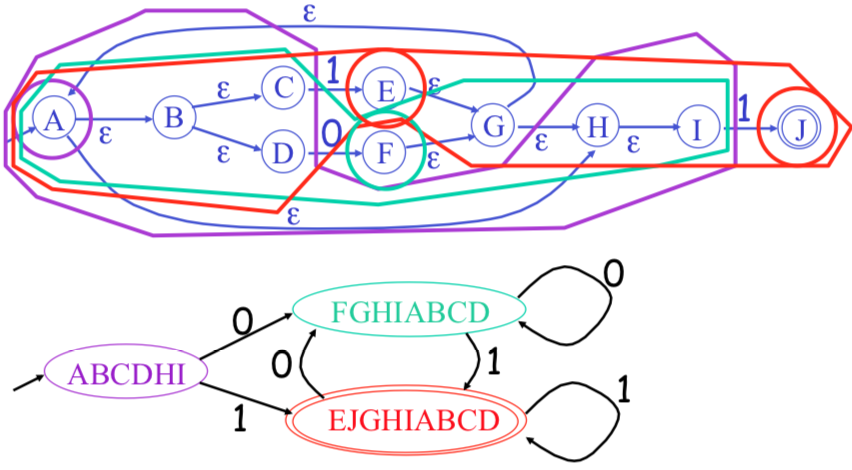Learning Compiler 4 Finite Automata
Note
Specifying Lexical Structure Using Regular Expressions
Union: $A|B\equiv A + B$
Option: $A + \epsilon \equiv A?$
Range: $'a'+'b'+\dots+'z'\equiv [a-z]$
Excluded range: complement of $[a-z] \equiv [\hat{}a-z]$
Regular Expressions => Lexical Spec.
- Write a rexp for the lexemes of each token
- Construct $R$, matching all lexemes for all tokens
- $R = \text{Keyword} + \text{Identifier} + \text{Number} + \dots \\ = R_1 + R_2 + \dots$
- Let input be $x_1\dots x_n$
- For $1 \leq i \leq n$ check $x_1\dots x_i\in L(R)$
- If success, then we know that $x_1\dots x_i\in L(R_j)$ for some $j$
- Remove $x_1\dots x_i$ from input and go to (3)
Ambiguities
Rule: Pick longest possible string in $L(R)$
Rule: Use rule listed first
Error handling
No rule matches a prefix of input
Solution:
- Write a rule matching all “bad” strings
- Put it last (lowest priority)
Summary
Regular expressions provide a concise notation for string patterns
Use in lexical analysis requires small extensions
- To resolve ambiguities
- To handle errors
Good algorithms known
- Require only single pass over the input
- Few operations per character (table lookup)
Finite Automata
Regular expressions = specification
Finite automata = implementation
A finite automaton consists of – An input alphabet $\Sigma$
- A set of states $S$
- A start state $n$
- A set of accepting states $F\subseteq S$
- A set of transitions state $\rightarrow^{\text{input}}$ state
Transition: $s_1 \rightarrow^{a} s_2$
Is read: In state $s_1$ on input “a” go to state $s_2$
If end of input and in accepting state => accept
Otherwise => reject
Finite Automata State Graphs

Epsilon Moves
$\epsilon$-moves

Machine can move from state A to state B without reading input
Deterministic and Nondeterministic Automata
Deterministic Finite Automata (DFA)
- One transition per input per state
- No $\epsilon$-moves
Nondeterministic Finite Automata (NFA)
- Can have multiple transitions for one input in a
given state - Can have $\epsilon$-moves
Execution of Finite Automata
A DFA can take only one path through the state graph
- Completely determined by input
NFAs can choose
- Whether to make $\epsilon$-moves
- Which of multiple transitions for a single input to take
Acceptance of NFAs
An NFA can get into multiple states
Rule: NFA accepts if it can get to a final state
NFA vs. DFA
NFAs and DFAs recognize the same set of languages (regular languages)
DFAs are faster to execute
- No choices to consider
For a given language NFA can be simpler than DFA
DFA can be exponentially larger than NFA
Regular Expressions to Finite Automata
High-level sketch:
Lexical Specification -> Regular Expressions -> NFA -> DFA -> Table-driven Implementation of DFA
Regular Expressions to NFA



NFA to DFA: The Trick
Simulate the NFA
Each state of DFA = a non-empty subset of states of the NFA
Start state = the set of NFA states reachable through $\epsilon$-moves from NFA start state
Add a transition $S \rightarrow^a S'$ to DFA iff $S'$ is the set of NFA states reachable from any
state in $S$ after seeing the input $a$, considering $\epsilon$-moves as well
NFA to DFA. Remark
An NFA may be in many states at any time
If there are N states, the NFA must be in some subset of those N states
How many subsets are there?
- $2^N - 1$ = finitely many
Example

Implementation
A DFA can be implemented by a 2D table T
- One dimension is “states”
- Other dimension is “input symbol”
- For every transition $S_i \rightarrow^a S_k$ define $T[i, a] = k$
DFA “execution”
- If in state $S_i$ and input $a$, read $T[i, a] = k$ and skip to state $S_k$
- Very efficient
NFA -> DFA conversion is at the heart of tools such as flex
DFAs can be huge
In practice, flex-like tools trade off speed for space in the choice of NFA and DFA representations
Reference
Slides: Finite Automata
Video: Compiler Stanford 2014